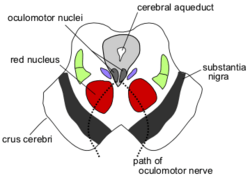Optic tectum facts for kids
| Brain: Superior colliculus | ||
|---|---|---|
Quick facts for kids
|
||
| Section through superior colliculus (unlabeled) showing path of oculomotor nerve | ||
| Scheme showing central connections of the optic nerves and optic tracts. (Superior colliculus visible near center.) | ||
| Latin | Colliculus superior | |
| Part of | Tectum | |
The superior colliculus is a special part of your brain. It's also called the optic tectum. This area is found in the midbrain, which is a central part of the brain in all vertebrates (animals with backbones).
In animals like fish, reptiles, and birds, the optic tectum is super important for seeing. It's like their main visual processing center. But in mammals, like humans, most of the detailed vision work happens in another part of the brain called the visual cortex. This is located at the back of the cerebral cortex.
Even though mammals use the visual cortex more, the superior colliculus still does some important visual processing. It also helps control how your eyes move. So, when you look at a human anatomy book and see "superior colliculus," it's talking about this same brain part.
Contents
How Your Brain Directs Your Eyes
Imagine the superior colliculus as a special map inside your brain. This map shows the world around you. Each tiny spot on this map is linked to a specific point in space.
When brain cells, called neurons, in a certain spot on this map become active, it tells your body to react towards that spot in the real world. In primates (like monkeys, apes, and humans), the superior colliculus is key for directing eye movements.
Visual information comes from your retina (the back of your eye). Or, commands can come from your cerebral cortex. Both can create a "bump" of activity on this brain map. If this activity is strong enough, it makes your eyes move.
More Than Just Eye Movements
The superior colliculus does more than just move your eyes. In primates, it also helps you turn your head. It can even help you reach out with your arms. Sometimes, it helps you shift your attention without any body movement at all.
In other animals, this brain part helps with many different actions. For example, it helps rats turn their whole body when walking. It helps fish swim and birds fly. It even helps frogs stick out their tongues to catch prey. And it helps snakes strike with their fangs!
Size Differences in Animals
In some animals that are not mammals, like fish and birds, the optic tectum is one of the biggest parts of their brain. It's huge!
But in mammals, especially primates, the cerebral cortex has grown much larger. This makes the superior colliculus seem much smaller compared to the whole brain. Even so, it's still the main control center for eye movements in mammals.
Images for kids
-
The brain of a cod, with the optic tectum highlighted
-
Drawing by Ramon y Cajal of several types of Golgi-stained neurons in the optic tectum of a sparrow.






